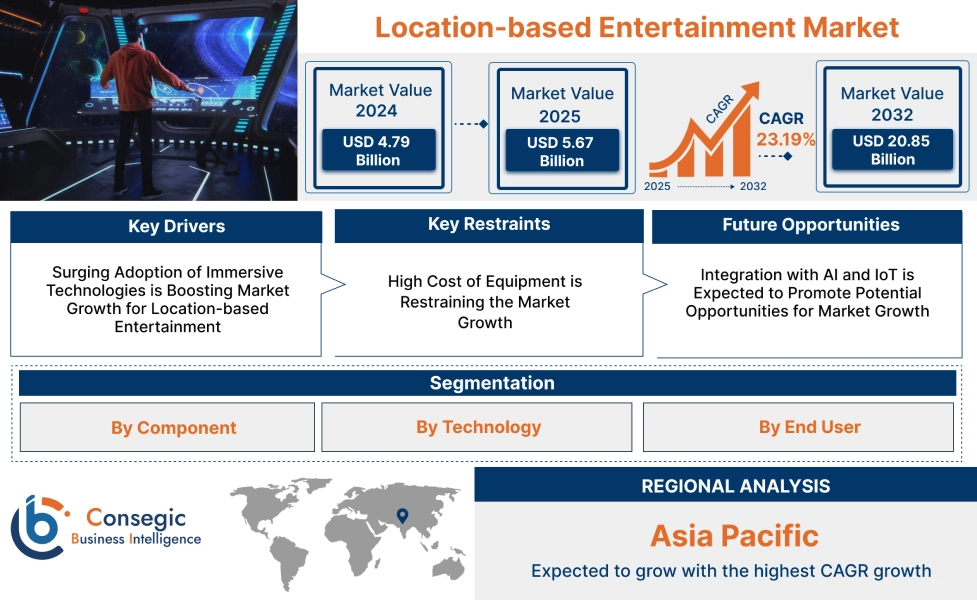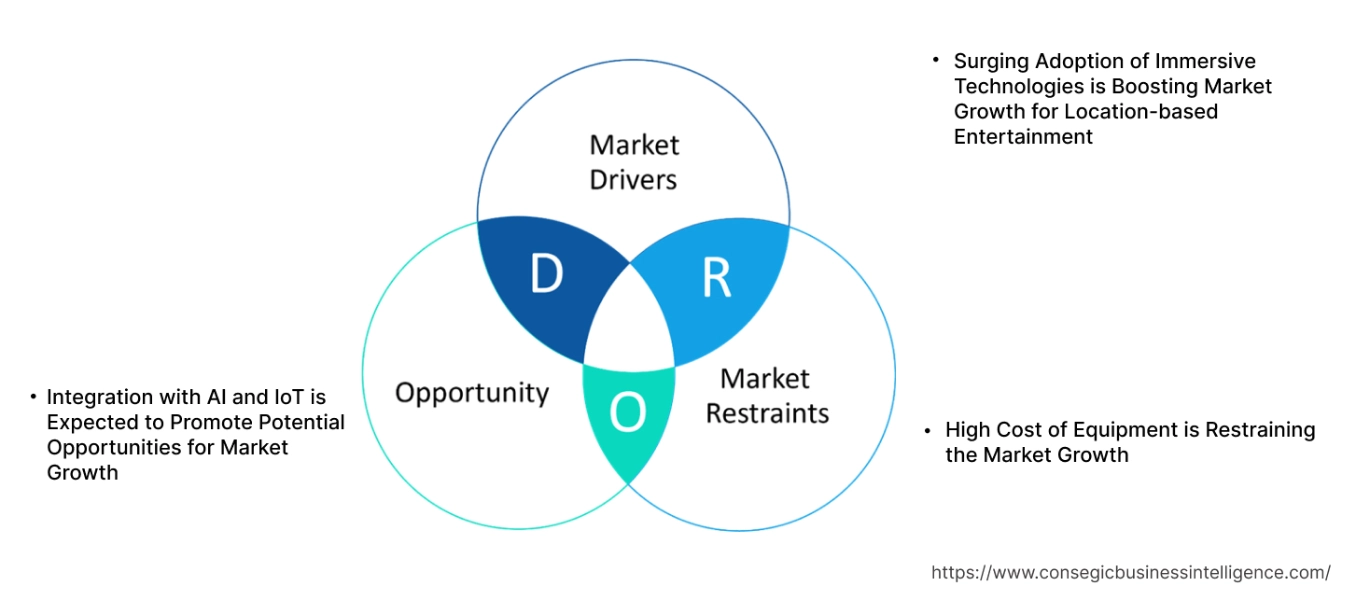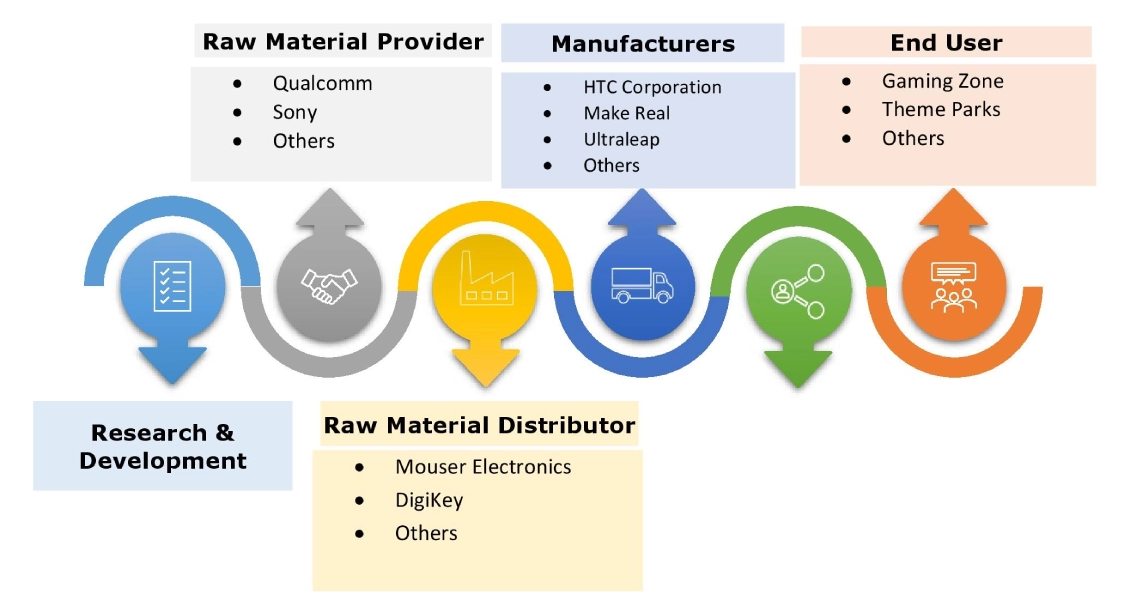Location-based Entertainment Market Size:
Location-based Entertainment Market size is estimated to reach over USD 20.85 Billion by 2032 from a value of USD 4.79 Billion in 2024 and is projected to grow by USD 5.67 Billion in 2025, growing at a CAGR of 23.19% from 2025 to 2032.
Location-based Entertainment Market Scope & Overview:
The rapidly evolving need for digital experiences with both physical and immersive experiences is driving the adoption of location-based entertainment (LBE) due to unique, interactive experiences that attract people towards engaging environments. Additionally, LBE is a form of entertainment that offers unique experiences to visitors in physical destinations. The solution aims to provide entertainment, education, and immersive experiences with the help of advanced technologies such as AR and VR among others which in turn is fueling the location-based entertainment market growth. Further, the rising need for engaging, high-quality experiences is driving the location-based entertainment market demand. Furthermore, the solution helps to attract more customers by providing immersive and interactive experiences which in turn is fueling the location-based entertainment industry.
Location-based Entertainment Market Dynamics - (DRO) :
Key Drivers:
Surging Adoption of Immersive Technologies is Boosting Market Growth for Location-based Entertainment
The surging adoption of immersive technologies such as virtual reality (VR), augmented reality (AR), and mixed reality (MR) is creating new and engaging experiences for consumers which in turn is boosting the location-based entertainment market growth. Additionally, VR, AR, and MR technologies are becoming more accessible and user-friendly due to a growing shift towards immersive entertainment which in turn is driving the location-based entertainment market demand. Further, the widespread availability of high-speed internet is paving the way for the adoption of immersive technology.
- For instance, in December 2022, According to Capgemini Research Institute, 77% of consumers expect immersive experiences helps to impact interaction with people, brands, and services which in turn is fueling the location-based entertainment market.
Therefore, the rising adoption of immersive technologies is driving the location-based entertainment services, in turn proliferating the growth of the market.
Key Restraints:
High Cost of Equipment is Restraining the Market Growth
The costs associated with developing and installing LBE are high, which in turn is hindering the location-based entertainment market expansion. Additionally, the motion capture technology, high-resolution projectors, and custom-designed spaces incur huge costs in turn hindering the adoption by service providers. Further, maintaining and upgrading hardware and software with rapid technological advancements is costly and is restraining market development. Furthermore, high cost restricts small companies and startups from entering the market creating a barrier to entry is hindering the location-based entertainment market share.
Therefore, the high costs of equipment utilized in providing immersive experiences to customers are restraining the location-based entertainment market expansion.
Future Opportunities :
Integration with AI and IoT is Expected to Promote Potential Opportunities for Market Growth
AI and IoT are revolutionizing LBE by creating more personalized, immersive, and efficient experiences which in turn is paving the way for location-based entertainment market opportunities. Additionally, AI and IoT enable real-time tracking and personalized engagement which in turn is boosting the location-based entertainment market evolution.
- For instance, in February 2025, InterDigital partnered with Keysight to launch high-accuracy AI-based sensing adaptable to dynamic environments for immersive experiences boosting the adoption of AI into the solution.
Hence, the rising integration of AI and IoT is anticipated to increase the utilization of in turn promoting prospects for location-based entertainment market opportunities during the forecast period.
Location-based Entertainment Market Segmental Analysis :
By Component:
Based on the component, the market is segmented into hardware, software, and services.
Trends in the component:
- The rising adoption of automation and real-time analytics in hardware and software components for delivering data-driven insights for improving customer experience is driving the location-based entertainment market trends.
- The proliferation of rental-based services or subscription-based business models is driving the location-based entertainment market trends.
Hardware accounted for the largest revenue share of 55.31% in the year 2024.
- The hardware components include VR headsets, motion sensors, high-performance computers, and others which play a key role in providing interactive and engaging environments.
- Additionally, the advantages of adopting hardware components include enhanced immersion, increased engagement, and the ability to deliver unique experiences that boost the location-based entertainment market size.
- Further, the increasing demand for immersive experiences is driving the adoption of hardware components, which in turn is boosting the location-based entertainment market share.
- For instance, in August 2022, Zero Latency partnered with HTC to offer a range of hardware and software features for LBE aiming to improve player experience and operational efficiency.
- Thus, according to the location-based entertainment market analysis, the increasing demand for immersive experience is driving the market progress.
Services are anticipated to register the fastest CAGR during the forecast period.
- The services component encompasses installation & maintenance, consulting services, and others.
- Additionally, the advantages of adopting services include increased user engagement, personalized experiences, and enhanced operational efficiency boosting the location-based entertainment market size.
- Further, the continuous improvements in advanced technologies are boosting the demand for services which in turn aims to increase the lifespan of hardware and software components.
- Furthermore, the rising disposable incomes and a greater willingness to spend on entertainment experiences are boosting the market demand, which in turn is fueling the services components.
- Therefore, according to the location-based entertainment market analysis, the improvements in advanced technologies are anticipated to boost the market during the forecast period.
By Technology:
Based on the technology, the market is segmented into augmented reality (AR), virtual reality (VR), mixed reality (MR), 3D projections, and others.
Trends in the Technology:
- The trend towards advancement in 5G and cloud computing is enhancing the capabilities and accessibility of MR technology.
- The trend towards rising adoption of generative AI into VR to accelerate content creation is boosting market progress.
Virtual Reality (VR) accounted for the largest revenue share in the year 2024.
- The shift from traditional entertainment venues such as theme parks to immersive and interactive experiences such as VR arcades and escape rooms is driving the market evolution.
- Additionally, the advancement in VR technology by integrating higher resolution displays and improved motion tracking among others offers an enhanced sense of immersion and realism.
- Further, the proliferation of VR arcades and escape rooms which offer fully immersive gaming experiences is boosting the virtual reality technology segment.
- For instance, in August 2024, iQIYI launched a VR immersive theater at Galaxy Macau aiming to enrich its portfolio of location-based entertainment experiences.
- Thus, as per the market analysis, the proliferation of VR arcades and escape rooms as well as advancement in VR technology is driving the market progress.
Augmented Reality (AR) is anticipated to register the fastest CAGR during the forecast period.
- Augmented reality overlays digital content onto the real world, creating immersive and interactive experiences that in turn provide unique, engaging, and memorable experiences.
- Additionally, the advancement in AR technology such as AR glasses, head-mounted displays, and mobile AR is boosting the market development.
- Further, the proliferation of AR-enhanced theme parks, gaming zones, and interactive attractions is driving the demand for augmented reality.
- Therefore, as per the market analysis, the proliferation of AR-enhanced theme parks, gaming zones, and interactive attractions is anticipated to boost the market during the forecast period.
By End User:
Based on the end user, the market is segmented into theme parks, movie theaters, arcades & gaming zones, escape rooms, and others.
Trends in the End User:
- The trend towards traditional arcade games is modernized with digital tracking and mobile app integration to offer a seamless and rewarding experience.
Theme Parks accounted for the largest revenue share in the year 2024.
- The proliferation of High-speed 5G networks which in turn enable seamless integration of digital and physical spaces is boosting the market progress.
- Additionally, the prevalence of social media due to the rising culture of sharing experiences is driving the market adoption in theme parks.
- Further, the rising adoption of advanced technologies such as AR, VR, MR, and others in theme parks is paving the way for market development.
- Furthermore, the integration allows for the creation of highly immersive and personalized experiences in theme parks.
- For instance, in May 2025, The Walt Disney Company and Miral announced the Plans for a new theme park and resort in Abu Dhabi aiming to provide a world-class immersive experience and entertainment.
- Thus, as per the market analysis, the rising adoption of advanced technologies as well as is driving the market progress.
Arcades & Gaming Zones is anticipated to register the fastest CAGR during the forecast period.
- Arcades are evolving beyond traditional coin-operated machines to integration with VR and AR technology aiming to boost market penetration.
- Additionally, the proliferation of competitive eSports elements is driving the market adoption in arcades & gaming zones.
- Further, the ongoing advancements in gaming technology are boosting the market adoption in arcades & gaming zones.
- Therefore, as per the market analysis, the ongoing advancements in gaming technology are anticipated to boost the market during the forecast period.
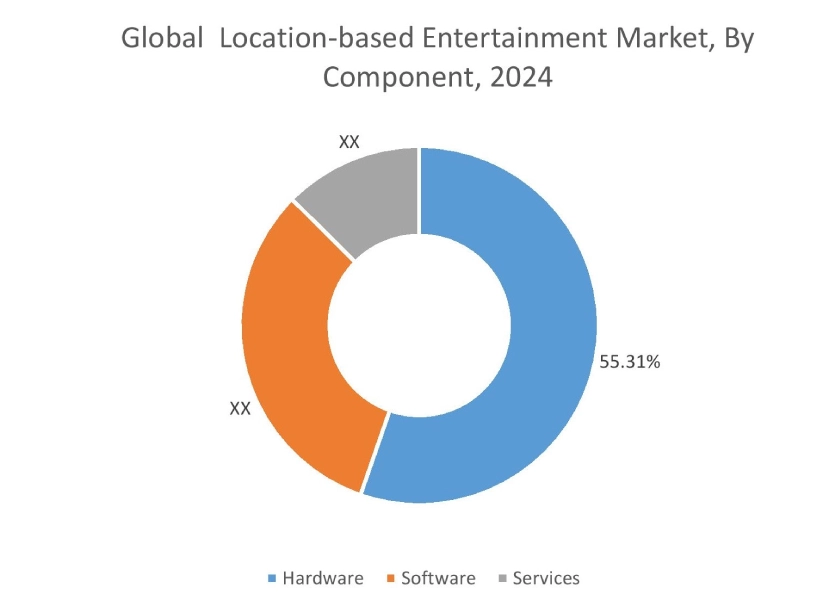
Regional Analysis:
The regions covered are North America, Europe, Asia Pacific, Middle East and Africa, and Latin America.
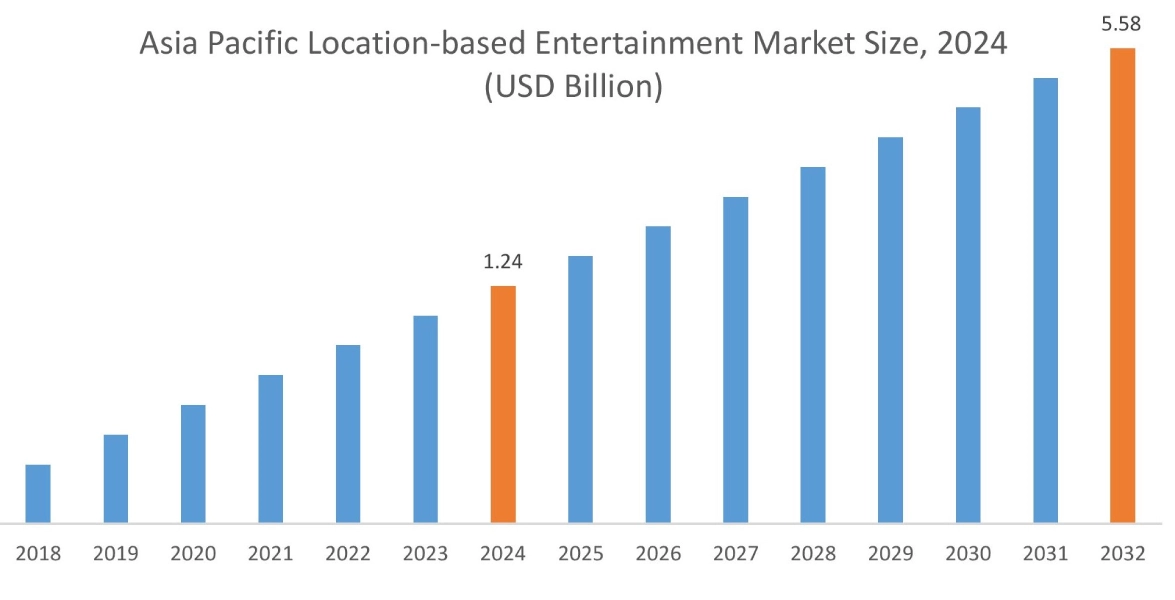
Asia Pacific region was valued at USD 1.24 Billion in 2024. Moreover, it is projected to grow by USD 1.47 Billion in 2025 and reach over USD 5.58 Billion by 2032. Out of this, China accounted for the maximum revenue share of 27.36%. The market growth is mainly driven by its deployment in escape rooms and others. Furthermore, factors including the increasing need for immersive and interactive entertainment experiences as well as increasing urbanization are projected to drive the market progress in Asia Pacific region during the forecast period.
- For instance, in November 2021, Merlin Entertainments based out in China, announced the launch of LEGOLAND which offers a unique international theme park experience. Additionally, the theme park incorporates traditional Chinese culture and modern interactive technology.
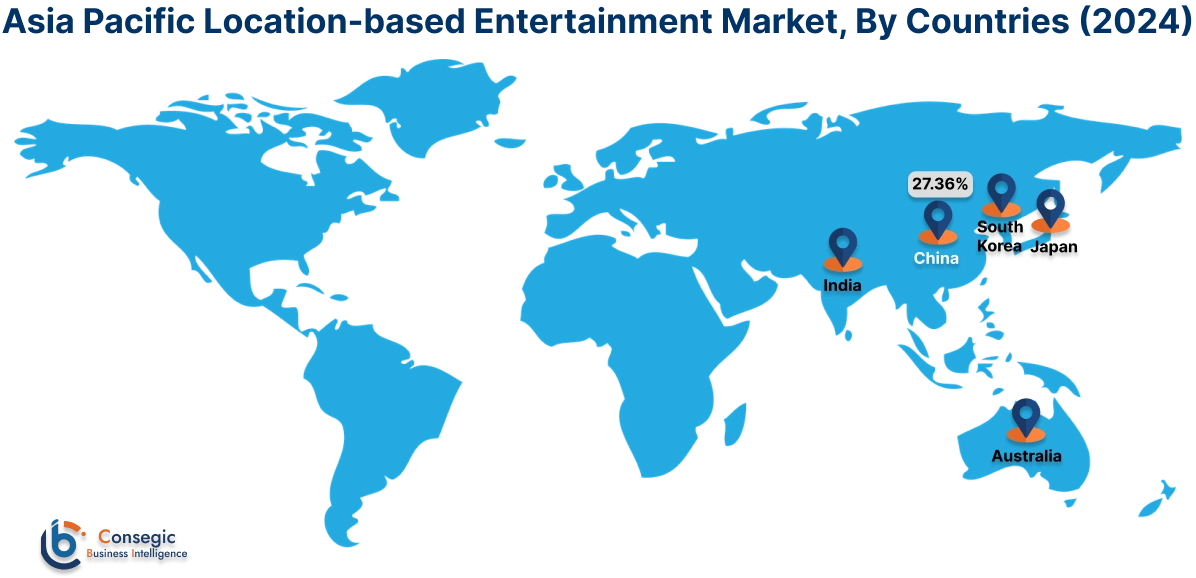
North America is estimated to reach over USD 6.87 Billion by 2032 from a value of USD 1.57 Billion in 2024 and is projected to grow by USD 1.86 Billion in 2025. The North American region's growing use of AI and automation offers lucrative growth prospects for the market. Additionally, the rise of themed entertainment centers is driving the market progress.
- For instance, in March 2022, Merlin Entertainment partnered with Sony Pictures Entertainment for the development of Merlin’s Resort Theme Parks and Waterparks based on the Jumanji film in Europe and North America.
The regional analysis depicts that the consumer shift toward amusement parks, arcades, 4D films, and others is driving the market in Europe. Additionally, the key factor driving the market is the growing gaming industry as well as the expansion of themed attractions is propelling the market adoption in the Middle East and African region. Further, the rising need for digital technologies with physical spaces is paving the way for the progress of the market in the Latin America region.
Top Key Players and Market Share Insights:
The global location-based entertainment market is highly competitive with major players providing solutions to the national and international markets. Key players are adopting several strategies in research and development (R&D), product innovation, and end user launches to hold a strong position in the location-based entertainment industry. Key players in the location-based entertainment market include-
- HTC Corporation (China)
- Make Real (UK)
- Hologate (Germany)
- 4Experience (UK)
- Sandbox VR (USA)
- Ultraleap (UK)
- Wikitude (Austria)
- Meta (USA)
- Samsung Electronics (South Korea)
- Void, LLC. (USA)
Recent Industry Developments :
Product launches
- In February 2025, Wevr launched a shared experience engine for applications in location-based entertainment. The technology aims to provide large-scale virtual shared experiences.
Partnerships & Collaborations
- In March 2025, FIU partnered with the Dolan Family Foundation to launch the D.R.E.A.M.S. program aiming to create new prospects for education, hands-on learning, and industry partnerships as well as prepare students for careers in immersive entertainment.
Location-based Entertainment Market Report Insights :
| Report Attributes | Report Details |
| Study Timeline | 2019-2032 |
| Market Size in 2032 | USD 20.85 Billion |
| CAGR (2025-2032) | 23.19% |
| By Component |
|
| By Technology |
|
| By End User |
|
| By Region |
|
| Key Players |
|
| North America | U.S. Canada Mexico |
| Europe | U.K. Germany France Spain Italy Russia Benelux Rest of Europe |
| APAC | China South Korea Japan India Australia ASEAN Rest of Asia-Pacific |
| Middle East and Africa | GCC Turkey South Africa Rest of MEA |
| LATAM | Brazil Argentina Chile Rest of LATAM |
| Report Coverage |
|
Key Questions Answered in the Report
How big is the location-based entertainment market? +
The location-based entertainment market size is estimated to reach over USD 20.85 Billion by 2032 from a value of USD 4.79 Billion in 2024 and is projected to grow by USD 5.67 Billion in 2025, growing at a CAGR of 23.19% from 2025 to 2032.
Which segmentation details are covered in the location-based entertainment report? +
The location-based entertainment report includes specific segmentation details for component, technology, end user, and regions.
Which is the fastest segment anticipated to impact the market growth? +
In the location-based entertainment market, virtual reality (VR) is the fastest-growing segment during the forecast period due to the proliferation of VR arcades and escape rooms as well as advancement in VR technology.
Who are the major players in the Location-based Entertainment market? +
The key participants in the location-based entertainment market are HTC Corporation (China), Make Real (UK), Ultraleap (UK), Wikitude (Austria), Meta (USA), Samsung Electronics (South Korea), Void, LLC. (USA), Hologate (Germany), 4Experience (UK), Sandbox VR (USA), and others.
What are the key trends in the Location-based Entertainment market? +
The location-based entertainment market is being shaped by several key trends including the rising adoption of generative AI into VR to accelerate content creation as well as the proliferation of rental-based services or subscription-based business models and others.
